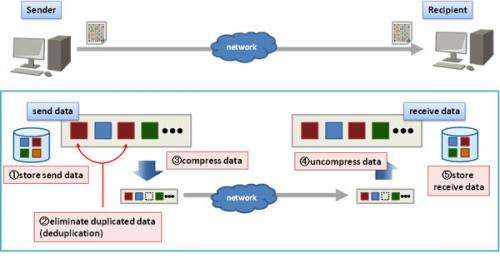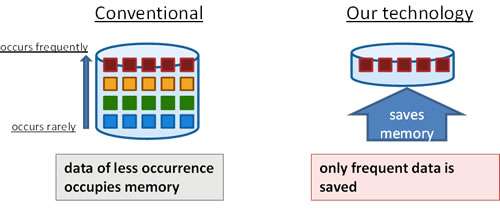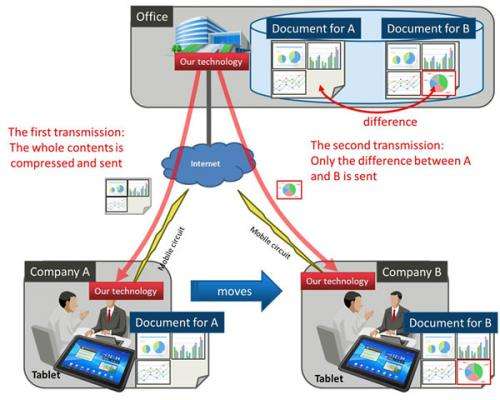Fujitsu develops data-transfer acceleration technology

Fujitsu Laboratories today announced the development of a technology for accelerating data transfer speeds that can be applied to various types of network environments used for cloud, mobile applications and other services.
Companies are today increasingly positioning their business systems in the cloud and consolidating their servers into datacenters. This is driving rapid growth in data transfer volume between multiple datacenters as well as datacenters and end-user equipment. While specialized hardware or network upgrades could speed up transfers, these are expensive approaches and cannot be easily deployed in cloud, virtual or mobile environments.
Fujitsu Laboratories has now developed a technology that uses data deduplication and compression to reduce the volume of data transfers, enabling dramatically greater data transfer speeds with only software. This technology can increase effective data-transfer rates by 10 times without the added cost of network upgrades, and can boost transfer speeds in a wide range of network environments between cloud datacenters and end-user equipment.
This technology will be exhibited at Fujitsu Forum 2014, running May 15-16 at Tokyo International Forum in Tokyo.
The popularity of cloud services and mobile devices is leading to ever-more applications available over networks that use a variety of communications environments. Every day, companies use datacenters for file transfers, file sharing, backups, and distributing data to mobile devices. Given that the volume of data transfers is expanding daily, there is a growing need to inexpensively accelerate data speeds without network upgrades or deployment of specialized equipment.
Previously, Fujitsu Laboratories conducted R&D on high-speed protocols as a way to accelerate data transfers. This is an effective method when a network's bandwidth is not being used to its full capacity. However, when bandwidth is fully utilized, solving problems such as network delays required network upgrades.
In order to accelerate transfers without upgrading networks, another effective approach is to reduce the volume of data being transferred. There are two techniques for doing this (Figure 1). One is data deduplication, where both sender and recipient save copies of data so that duplicated data transmission can be eliminated. The other is to compress data using file-compression technology. Data deduplication and compression technologies are already used in storage systems and specialized hardware for accelerating data transfers, and are effective in accelerating transfer rates. But implementing these technologies in software so that they can be used with mobile devices, for example, poses the following problems:

Data deduplication relies on both sender and recipient to save copies of data, and this is difficult to implement on mobile devices that have limited storage capacity.
Both deduplication and compression are processor-intensive, and on mobile devices that have limited CPU power, these techniques can slow down effective transfer rates.
About the Technology
Fujitsu has now developed high-speed data transfer technology that can effectively boost data transfer speeds even on mobile devices, using software to cut data volumes, leveraging data deduplication and compression technologies. Features of the technology are as follows.
1. High deduplication performance by minimizing storage requirement
Fujitsu Laboratories has developed a technology that selects data that appears with high statistical frequency on the network and prioritizes it for saving. This maintains high deduplication performance while reducing the volume of low-frequency data being saved, so that the limited memory on mobile devices can be used more effectively. In internal testing, this was found to reduce the volume of duplicate data saved in the mobile device's storage by as much as 80%.
2. Lightweight data compression technology
Fujitsu Laboratories has developed a technology that reduces the CPU load imposed by the compression process to as little as one-fourth the level of conventional technologies. This technology searches for repeating patterns that appear within the data. When no pattern is found, it searches at longer intervals. When a pattern is found, data in close proximity is searched in particular detail. This results in efficient searching overall, while greatly reducing the time required for compression.

3. Automatic selection technology for operational improvements
Deduplication and compression of transfer data will at times lower data transfer rates when the size of data to be transferred is small and duplication is rarely found on the data. The net effectiveness of these techniques depends on data size, available network bandwidth, and CPU power. This technology will therefore periodically evaluate these parameters, assess the acceleration benefits, and determine whether deduplication or compression will be effective in practice. This frees system administrators from needing to configure settings for every deployed environment and improves operations.
Results
This newly developed technology is expected to lead to easier use of a variety of network applications in the cloud, and in virtual and mobile environments that are anticipated to continue to become more prevalent. This technology being available as software means that it can be integrated into existing servers and operating systems to bring its benefits to notebook computers, tablets, smartphones, and other mobile devices.
In one possible scenario, a salesman visiting Company A would download sales materials for Company A from headquarters, and then when visiting Company B would download slightly different sales materials for Company B. The parts of these materials that are the same would not need to be re-downloaded, effectively increasing download speeds (Figure 3). Over a 10 Mbps connection of available bandwidth, this has been shown to increase effective transfer rates 10 times.
Fujitsu Laboratories will be conducting practical testing of this technology with the goal of commercializing during fiscal 2014. This will contribute to greater quality with everything from datacenters on wide-area networks to end users on mobile devices.
Provided by Fujitsu





















